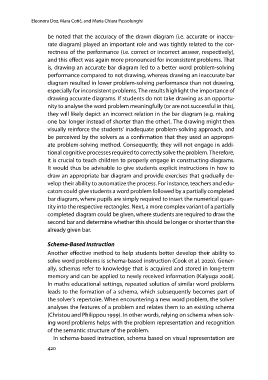Page 420 - Istenič Andreja, Gačnik Mateja, Horvat Barbara, Kukanja Gabrijelčič Mojca, Kiswarday Vanja Riccarda, Lebeničnik Maja, Mezgec Maja, Volk Marina. Ur. 2023. Vzgoja in izobraževanje med preteklostjo in prihodnostjo. Koper: Založba Univerze na Primorskem
P. 420
onora Doz, Mara Cotič, and Maria Chiara Passolunghi
be noted that the accuracy of the drawn diagram (i.e. accurate or inaccu-
rate diagram) played an important role and was tightly related to the cor-
rectness of the performance (i.e. correct or incorrect answer, respectively),
and this effect was again more pronounced for inconsistent problems. That
is, drawing an accurate bar diagram led to a better word problem-solving
performance compared to not drawing, whereas drawing an inaccurate bar
diagram resulted in lower problem-solving performance than not drawing,
especially for inconsistent problems. The results highlight the importance of
drawing accurate diagrams. If students do not take drawing as an opportu-
nity to analyse the word problem meaningfully (or are not successful in this),
they will likely depict an incorrect relation in the bar diagram (e.g. making
one bar longer instead of shorter than the other). The drawing might then
visually reinforce the students’ inadequate problem-solving approach, and
be perceived by the solvers as a confirmation that they used an appropri-
ate problem-solving method. Consequently, they will not engage in addi-
tional cognitive processes required to correctly solve the problem. Therefore,
it is crucial to teach children to properly engage in constructing diagrams.
It would thus be advisable to give students explicit instructions in how to
draw an appropriate bar diagram and provide exercises that gradually de-
velop their ability to automatize the process. For instance, teachers and edu-
cators could give students a word problem followed by a partially completed
bar diagram, where pupils are simply required to insert the numerical quan-
tity into the respective rectangles. Next, a more complex variant of a partially
completed diagram could be given, where students are required to draw the
second bar and determine whether this should be longer or shorter than the
already given bar.
Schema-Based Instruction
Another effective method to help students better develop their ability to
solve word problems is schema-based instruction (Cook et al. 2020). Gener-
ally, schemas refer to knowledge that is acquired and stored in long-term
memory and can be applied to newly received information (Kalyuga 2008).
In maths educational settings, repeated solution of similar word problems
leads to the formation of a schema, which subsequently becomes part of
the solver’s repertoire. When encountering a new word problem, the solver
analyses the features of a problem and relates them to an existing schema
(Christou and Philippou 1999). In other words, relying on schema when solv-
ing word problems helps with the problem representation and recognition
of the semantic structure of the problem.
In schema-based instruction, schema based on visual representation are
420
be noted that the accuracy of the drawn diagram (i.e. accurate or inaccu-
rate diagram) played an important role and was tightly related to the cor-
rectness of the performance (i.e. correct or incorrect answer, respectively),
and this effect was again more pronounced for inconsistent problems. That
is, drawing an accurate bar diagram led to a better word problem-solving
performance compared to not drawing, whereas drawing an inaccurate bar
diagram resulted in lower problem-solving performance than not drawing,
especially for inconsistent problems. The results highlight the importance of
drawing accurate diagrams. If students do not take drawing as an opportu-
nity to analyse the word problem meaningfully (or are not successful in this),
they will likely depict an incorrect relation in the bar diagram (e.g. making
one bar longer instead of shorter than the other). The drawing might then
visually reinforce the students’ inadequate problem-solving approach, and
be perceived by the solvers as a confirmation that they used an appropri-
ate problem-solving method. Consequently, they will not engage in addi-
tional cognitive processes required to correctly solve the problem. Therefore,
it is crucial to teach children to properly engage in constructing diagrams.
It would thus be advisable to give students explicit instructions in how to
draw an appropriate bar diagram and provide exercises that gradually de-
velop their ability to automatize the process. For instance, teachers and edu-
cators could give students a word problem followed by a partially completed
bar diagram, where pupils are simply required to insert the numerical quan-
tity into the respective rectangles. Next, a more complex variant of a partially
completed diagram could be given, where students are required to draw the
second bar and determine whether this should be longer or shorter than the
already given bar.
Schema-Based Instruction
Another effective method to help students better develop their ability to
solve word problems is schema-based instruction (Cook et al. 2020). Gener-
ally, schemas refer to knowledge that is acquired and stored in long-term
memory and can be applied to newly received information (Kalyuga 2008).
In maths educational settings, repeated solution of similar word problems
leads to the formation of a schema, which subsequently becomes part of
the solver’s repertoire. When encountering a new word problem, the solver
analyses the features of a problem and relates them to an existing schema
(Christou and Philippou 1999). In other words, relying on schema when solv-
ing word problems helps with the problem representation and recognition
of the semantic structure of the problem.
In schema-based instruction, schema based on visual representation are
420


